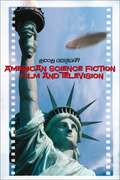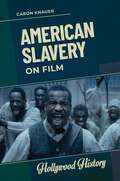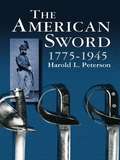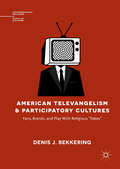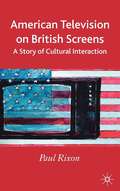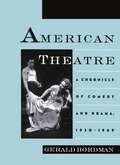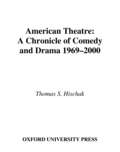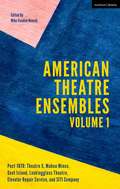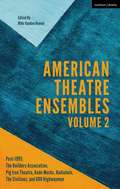- Table View
- List View
American Science Fiction Film and Television
by Lincoln GeraghtyAmerican Science Fiction Film and Television presents a critical history of late 20th Century SF together with an analysis of the cultural and thematic concerns of this popular genre. Science fiction film and television were initially inspired by the classic literature of HG Wells and Jules Verne. The potential and fears born with the Atomic age fuelled the popularity of the genre, upping the stakes for both technology and apocalypse. From the Cold War through to America's current War on Terror, science fiction has proved a subtle vehicle for the hopes, fears and preoccupations of a nation at war.The definitive introduction to American science fiction, this is also the first study to analyse SF across both film and TV. Throughout, the discussion is illustrated with critical case studies of key films and television series, including The Day the Earth Stood Still, Planet of the Apes, Star Trek: The Next Generation, The X-Files, and Battlestar Galactica.
American Science Fiction Television and Space: Productions and (Re)configurations (1987-2021)
by Joel Hawkes Alex Christie Tom NienhuisThis collection reads the science fiction genre and television medium as examples of heterotopia (and television as science fiction technology), in which forms, processes, and productions of space and time collide – a multiplicity of spaces produced and (re)configured. The book looks to be a heterotopic production, with different chapters and “spaces” (of genre, production, mediums, technologies, homes, bodies, etc), reflecting, refracting, and colliding to offer insight into spatial relationships and the implications of these spaces for a society that increasingly inhabits the world through the space of the screen. A focus on American science fiction offers further spatial focus for this study – a question of geographical and cultural borders and influence not only in terms of American science fiction but American television and streaming services. The (contested) hegemonic nature of American science fiction television will be discussed alongside a nation that has significantly been understood, even produced, through the television screen. Essays will examine the various (re)configurations, or productions, of space as they collapse into the science fiction heterotopia of television since 1987, the year Star Trek: Next Generation began airing.
American Science Fiction TV: Star Trek, Stargate and Beyond (Popular Television Genres)
by Jan Johnson-SmithFrom "The Next Generation" and "The X-Files", to "Farscape" and "Enterprise", sci-fi television series in the US have multiplied since the 1980s. Jan Johnson-Smith shows how, in line with national political upheavals, this vibrant and perplexing genre set about expanding the myth of the Western frontier into deep space. She looks at the "sense of wonder" or sublime that infuses much Frontier art and science fiction, and traces a possible historical precedent to the genre in the fabulous and heroic journeys of the Classical epic. She discusses narrative styles and their influences, from the overarching narrative of "Babylon 5" to the episodic formula of "The Outer Limits", considers how experimental series such as "Twin Peaks" challenge conventional structures, and how and why sci-fi television has adopted new technologies. She also explores the juxtaposition of arcane language and technological jargon in modern American sci-fi television, revealing the extraordinarily alien, yet curiously familiar arena it creates.
American Scream: The Bill Hicks Story
by Cynthia TrueHe was a radical stand up who dared to question the values of small town America and the evils of American foreign policy. Ruthlessly honest, a voice of reason in what he saw as an insane world, Hicks refused to compromise in spite of the censorship he faced for most of his career. His entire act was once banned from The Late Show with David Letterman because he made fun of pro-lifers and the Pope. In American Scream Cynthia True gets under the skin of Hicks, the heavy-drinking, chain-smoking, drug-taking philosopher who was also gentle and kind, a good friend and a comic genius who packed enough adventure into his three decades to last three lifetimes. Hicks died of pancreatic cancer in 1994 but his comedy is more relevant today than ever. This vivid, funny, insightful book shows why. 'Conscientious, perceptive and affectionate . . . [True] understands her subject perfectly' Independent 'Intelligent and tightly researched' Guardian
American Silences: The Realism of James Agee, Walker Evans, and Edward Hopper
by Joseph WardIn ""American Silences"", Joseph Anthony Ward offers a unique analysis of the use and effects of silence in modern American realistic art. Beginning with the nineteenth-century literature that laid the foundation for silence in art, he moves to a brief analysis of Sherwood Anderson's ""Winesburg"", Ohio and Ernest Hemingway's ""In Our Time"", showing how they, along with several other crucial works of twentieth-century American realism, incorporate the power of the silent into their expression without sacrificing the subjects and techniques of traditional realism. Examining ""Let Us Now Praise Famous Men"", James Agee's commentary on the life of tenant farmers, documented with photographs by Walker Evans, Ward traces the book's pattern of 'silence, then silence disturbed by sound, and ultimately silence restored'. Ward further supports his theory with a study of Agee's ""A Death in the Family"" and Evans' ""American Photographs"". Ward sees Agee's admiration of photography as a connection between the silence of the scenes he writes about and the silence of Evans' photographs. The use of silence is perhaps even more obvious in the paintings of Edward Hopper. Although throughout the book Ward suggests both the positive and negative qualities of silence in art, Hopper's paintings provide little in the way of postiveness. For Ward, the art of silence is an art of extreme concentration that seeks essences rather than superficiality that nearly transcends realism itself. The theme of silence in American realism is a significant new one, but Ward's interpretation of the prose and his analysis of the photographs and paintings, many of which are reproduced in this book, establish validity for art as the voice of silence.
American Silences: The Realism of James Agee, Walker Evans, and Edward Hopper
by Joseph Anthony WardIn ""American Silences"", Joseph Anthony Ward offers a unique analysis of the use and effects of silence in modern American realistic art. Beginning with the nineteenth-century literature that laid the foundation for silence in art, he moves to a brief analysis of Sherwood Anderson's ""Winesburg"", Ohio and Ernest Hemingway's ""In Our Time"", showing how they, along with several other crucial works of twentieth-century American realism, incorporate the power of the silent into their expression without sacrificing the subjects and techniques of traditional realism. Examining ""Let Us Now Praise Famous Men"", James Agee's commentary on the life of tenant farmers, documented with photographs by Walker Evans, Ward traces the book's pattern of 'silence, then silence disturbed by sound, and ultimately silence restored'. Ward further supports his theory with a study of Agee's ""A Death in the Family"" and Evans' ""American Photographs"". Ward sees Agee's admiration of photography as a connection between the silence of the scenes he writes about and the silence of Evans' photographs. The use of silence is perhaps even more obvious in the paintings of Edward Hopper. Although throughout the book Ward suggests both the positive and negative qualities of silence in art, Hopper's paintings provide little in the way of postiveness. For Ward, the art of silence is an art of extreme concentration that seeks essences rather than superficiality that nearly transcends realism itself. The theme of silence in American realism is a significant new one, but Ward's interpretation of the prose and his analysis of the photographs and paintings, many of which are reproduced in this book, establish validity for art as the voice of silence.
American Silver
by John Marshall PhillipsA practical guide to recognizing, identifying, and appreciating the finest American silverwork. Photographs and drawings of masterworks from leading collections show some of the finest work by Jacob Hurd, Jeremiah Dummer, Peter van Dyck, Edward Winslow, John Coney, Paul Revere, and other renowned silversmiths. 52 halftones, 14 black-and-white line illustrations.
American Silversmiths and Their Marks: The Definitive (1948) Edition
by Stephen G. Ensko"So thoroughly is the American ethos embodied in the works of American silversmiths that it has given to their product a typical identity and it never can be mistaken for that of any other country." -- Charles Messer Stow in the Introduction.Forsaking the flourishes and ornamentation favored by their European contemporaries, early American gold- and silver smiths pioneered a new American aesthetic sensibility in creating for their well-heeled clients finely worked, luxurious metalware for the table, which was marked by a simplicity and forthrightness of design. These accomplished artisans have left us not only a stunning legacy of priceless silverware but also an opportunity to examine the culture, lifestyle, and values -- in short, the developing ethos -- of young America. For social and cultural historians as well as Americana buffs, the study of silversmithing in this book will provide a unique perspective on a spirited new nation. For serious connoisseurs of American gold and silver ware, silver dealer Stephen G. C. Ensko's American Silversmiths and Their Marks is a rich and definitive directory. Ensko has compiled an exhaustive list of over 3,000 gold- and silversmiths working between the years 1650 and 1850. Biographical details and location of their shops are given wherever possible. Maps of the great metropolitan centers of smithing (Boston, New York, and Philadelphia) with shop locations noted are appended. Over 200 of the finest examples of the work of early American artisans are displayed in sharp, clear black-and-white photographs. Items include tankards, cups, candlesticks, sugar boxes, inkstands, tea sets, porringers, plus a pitcher, sauce dish, teapot, and other works by famous New England patriot Paul Revere. The usefulness of this work is perhaps most apparent in the practical listing of identifying marks associated with gold- and silversmiths. With over 3,000 entries, this feature alone renders American Silversmiths and Their Marks indispensable to enthusiasts interested in tracking down and identifying antique pieces.
American Slavery and Russian Serfdom in the Post-Emancipation Imagination
by Amanda Brickell BellowsThe abolition of Russian serfdom in 1861 and American slavery in 1865 transformed both nations as Russian peasants and African Americans gained new rights as subjects and citizens. During the second half of the long nineteenth century, Americans and Russians responded to these societal transformations through a fascinating array of new cultural productions. Analyzing portrayals of African Americans and Russian serfs in oil paintings, advertisements, fiction, poetry, and ephemera housed in American and Russian archives, Amanda Brickell Bellows argues that these widely circulated depictions shaped collective memory of slavery and serfdom, affected the development of national consciousness, and influenced public opinion as peasants and freedpeople strove to exercise their newfound rights. While acknowledging the core differences between chattel slavery and serfdom, as well as the distinctions between each nation's post-emancipation era, Bellows highlights striking similarities between representations of slaves and serfs that were produced by elites in both nations as they sought to uphold a patriarchal vision of society. Russian peasants and African American freedpeople countered simplistic, paternalistic, and racist depictions by producing dignified self-representations of their traditions, communities, and accomplishments. This book provides an important reconsideration of post-emancipation assimilation, race, class, and political power.
American Slavery on Film (Hollywood History)
by Caron KnauerA comprehensive and timely resource on the depictions in film of enslaved African Americans and slavery from the Antebellum Period to Emancipation.American Slavery on Film highlights historical and contemporary depictions in film of the resistance, rebellion, and resilience of enslaved African Americans in the United States from the Antebellum period to Emancipation. In her study of such films as Uncle Tom's Cabin (1914), a silent movie adaptation of Harriet Beecher Stowe's novel; the groundbreaking and successful television miniseries Roots (1977); and the Harriet Tubman biopic Harriet (2019), Caron Knauer analyzes how African American slavery has been and continues to be portrayed in major studio blockbusters and independent films alike. Separating the romanticized and unrealistic depictions of slavery from the more accurate but often unflinching portrayals of its horrors, the author covers a wide range of topics, including the impact of slavery on popular culture, the Underground Railroad, Maroon communities, and the Los Angeles Film Rebellion of the 1960s. As a result, this book delivers a comprehensive, readable, and timely examination of enslaved African Americans and slavery in America's film history.
American Slavery on Film (Hollywood History)
by Caron KnauerA comprehensive and timely resource on the depictions in film of enslaved African Americans and slavery from the Antebellum Period to Emancipation.American Slavery on Film highlights historical and contemporary depictions in film of the resistance, rebellion, and resilience of enslaved African Americans in the United States from the Antebellum period to Emancipation. In her study of such films as Uncle Tom's Cabin (1914), a silent movie adaptation of Harriet Beecher Stowe's novel; the groundbreaking and successful television miniseries Roots (1977); and the Harriet Tubman biopic Harriet (2019), Caron Knauer analyzes how African American slavery has been and continues to be portrayed in major studio blockbusters and independent films alike. Separating the romanticized and unrealistic depictions of slavery from the more accurate but often unflinching portrayals of its horrors, the author covers a wide range of topics, including the impact of slavery on popular culture, the Underground Railroad, Maroon communities, and the Los Angeles Film Rebellion of the 1960s. As a result, this book delivers a comprehensive, readable, and timely examination of enslaved African Americans and slavery in America's film history.
American Smart Cinema (Traditions in World Cinema)
by Claire PerkinsAmerican Smart Cinema examines a contemporary type of US filmmaking that exists at the intersection of mainstream, art and independent cinema and often gives rise to absurd, darkly comic and nihilistic effects.Connecting the 'smart' sensibility to issues of expressive irony, generational divide and therapeutic culture, this bold new book describes a recent critical tradition in commercial-independent American filmmaking by exploring the unstable tone and dysfunctional themes of such films as The Royal Tenenbaums, Adaptation, The Squid and the Whale, Palindromes, The Last Days of Disco, Flirt, Ghost World, Your Friends and Neighbors, Donnie Darko and The Savages. Acknowledging the loaded forms of expression employed by these films, American Smart Cinema provides new directions for their study by discussing the self-conscious approach taken to film historical discourses of authorship, narrative and genre. Examining the smart film's taste for 'blank' style and issues of middle-class identity, the book provides a comprehensive account of smart cinema as an aesthetic category while also considering the cultural and political factors that have guaranteed it critical and popular success.
American Smart Cinema (Traditions in World Cinema)
by Claire PerkinsAmerican Smart Cinema examines a contemporary type of US filmmaking that exists at the intersection of mainstream, art and independent cinema and often gives rise to absurd, darkly comic and nihilistic effects.
The American Success Myth on Film
by J. LevinsonIn examining the enduring appeal that rags-to-riches stories exert on our collective imagination, this book highlights the central role that films have played in the ongoing cultural discourse about success and work in America.
The American Sword 1775-1945
by Harold L. PetersonThe first book devoted exclusively to the subject, this invaluable volume will aid collectors, curators, historians. Enhanced with more than 400 illustrations from rare documents, the book classifies and describes all major types of swords worn by the U.S. armed forces, cadets, and diplomats since the American Revolution to the end of World War II.
American Televangelism and Participatory Cultures: Fans, Brands, and Play With Religious "Fakes" (Contemporary Religion and Popular Culture)
by Denis J. BekkeringThis book examines unintended participatory cultures and media surrounding the American televangelists Robert Tilton and Tammy Faye Bakker-Messner. It brings to light heavily ironic fan followings; print, audio, and video projects; public access television parodies; and other comedic participatory practices associated with these controversial preachers from the 1980s onwards. For Tilton’s ministry, some of these activities and artifacts would prove irksome and even threatening, particularly an analog video remix turned online viral sensation. In contrast, Bakker-Messner’s “campy” fans – gay men attracted to her “ludicrous tragedy” – would provide her unexpected opportunities for career rehabilitation. Denis J. Bekkering challenges “supply-side” religious economy and branding approaches, suggestions of novelty in religion and “new” media studies, and the emphasis on sincere devotion in research on religion and fandom. He also highlights how everyday individuals have long participated in public negotiations of Christian authenticity through tongue-in-cheek play with purported religious “fakes.”
American Television on British Screens: A Story of Cultural Interaction
by P. RixonThis work explores how American programmes have become an important part of British television culture since the 1950's, moving from schedule fillers to cornerstones and 'must see' attractions. The book analyses popular and industrial discourses, the changing roles of such programmes on British screens and interviews with key British broadcasters.
American Theatre: A Chronicle of Comedy and Drama, 1930-1969
by Gerald BordmanThis book concludes Gerald Bordman's acclaimed survey of American non-musical theatre. It deals with the years 1930 to 1970, a period when the number of yearly new plays was shrinking, but a period during which American drama as a whole entered the world stage and became a dominant force. With works like Eugene O'Neill's Long Day's Journey Into Night, Tennessee William's A Streetcar Named Desire, and Arthur Miller's Death of a Salesman, American theater finally reached adulthood both dramatically and psychologically. Bordman's lively, authoritative study covers every Broadway production, as well as every major off-Broadway show. His discussion moves season by season and show by show in chronological order; he offers plot synopses and details the physical production, directors, players, theaters, and newspaper reviews. This book and the preceding volumes of American Theatre stand as the premier history of American drama.
American Theatre: A Chronicle of Comedy and Drama, 1969-2000
by Thomas S. HischakVolume Four of the distinguished American Theatre: A Chronicle of Comedy and Drama series offers a thorough, candid, and fascinating look at the theater in New York during the last decades of the twentieth century.
American Theatre: History, Context, Form (Baas Paperbacks Ser.)
by Theresa SaxonArgues for the recognition of American theatre history as long, rich, diverse and critically compelling. Embracing all epochs of theatre history, from pre-colonial Native American performance rituals and the endeavours of early colonisers in the sixteenth and seventeenth centuries, to the end of the twentieth century, Theresa Saxon situates American theatre as a lively, dynamic and diverse arena. She considers the implications of political manoeuvrings, economics - state-funding and commercial enterprises - race and gender, as well as material factors such as technology, riot and fire, as major forces in determining the structure of America's playhouses and productions. She goes on to investigate critical understandings of the term 'theatre,' and assesses ways in which the various values of commerce, entertainment, education and dramatic production have informed the definition of theatre throughout America's history.
American Theatre: History, Context, Form (BAAS Paperbacks)
by Theresa SaxonThis book provides a brief yet informative evaluation of the variety and complexity of theatrical endeavours in the United States, embracing all epochs of theatre history and situating American theatre as a lively, dynamic and diverse arena.
American Theatre Ensembles Volume 1: Post-1970: Theatre X, Mabou Mines, Goat Island, Lookingglass Theatre, Elevator Repair Service, and SITI Company
by Mike Vanden HeuvelAcross two volumes, Mike Vanden Heuvel and a strong roster of contributors present the history, processes, and achievements of American theatre companies renowned for their use of collective and/or ensemble-based techniques to generate new work. This first study considers theatre companies that were working between 1970 and 1995: it traces the rise and eventual diversification of activist-based companies that emerged to serve particular constituencies from the countercultural politics of the 1960s, and examines the shift in the 1980s that gave rise to the next generation of company-based work, rooted in a new interest in form and the more mediated and dispersed forms of politics. Ensembles examined are Mabou Mines, Theatre X, Goat Island, Lookingglass, Elevator Repair Service, and SITI Company.Preliminary chapters provide a sweeping overview of ensemble-based creation within the general historical and cultural contexts of the period, followed by a detailed study of the evolution of ensemble-based work. The case studies consider factors such as influence, funding, production, and legacies, as well as the forms of collective devising and creation, while surveying the continuing work of significant long-running companies.Contributors provide detailed case studies of the 6 companies from the period and cover:* A chronicle of development and methods* Key productions and projects* Critical reception and legacy* A chronological overview of significant productionsFrom the long history of collective theatre creation, with its sources in social crises, urgent aesthetic experimentation and utopian dreaming, American ensemble-based theatre has emerged at several key points in history to challenge the primacy of author-based and director-produced theatre. As the volume demonstrates, US ensemble companies have collectively revolutionized the form and content of contemporary performance, influencing experimental, as well as mainstream practice.
American Theatre Ensembles Volume 1: Post-1970: Theatre X, Mabou Mines, Goat Island, Lookingglass Theatre, Elevator Repair Service, and SITI Company
Across two volumes, Mike Vanden Heuvel and a strong roster of contributors present the history, processes, and achievements of American theatre companies renowned for their use of collective and/or ensemble-based techniques to generate new work. This first study considers theatre companies that were working between 1970 and 1995: it traces the rise and eventual diversification of activist-based companies that emerged to serve particular constituencies from the countercultural politics of the 1960s, and examines the shift in the 1980s that gave rise to the next generation of company-based work, rooted in a new interest in form and the more mediated and dispersed forms of politics. Ensembles examined are Mabou Mines, Theatre X, Goat Island, Lookingglass, Elevator Repair Service, and SITI Company.Preliminary chapters provide a sweeping overview of ensemble-based creation within the general historical and cultural contexts of the period, followed by a detailed study of the evolution of ensemble-based work. The case studies consider factors such as influence, funding, production, and legacies, as well as the forms of collective devising and creation, while surveying the continuing work of significant long-running companies.Contributors provide detailed case studies of the 6 companies from the period and cover:* A chronicle of development and methods* Key productions and projects* Critical reception and legacy* A chronological overview of significant productionsFrom the long history of collective theatre creation, with its sources in social crises, urgent aesthetic experimentation and utopian dreaming, American ensemble-based theatre has emerged at several key points in history to challenge the primacy of author-based and director-produced theatre. As the volume demonstrates, US ensemble companies have collectively revolutionized the form and content of contemporary performance, influencing experimental, as well as mainstream practice.
American Theatre Ensembles Volume 2: Post-1995: The Builders Association, Pig Iron Theatre, Rude Mechs, Radiohole, The Civilians, and 600 Highwaymen
by Mike Vanden HeuvelA companion to American Theatre Ensembles Volume 1, this volume charts the development and achievements of theatre companies working after 1995, bringing together the diffuse generation of ensembles working within a context of media saturation and epistemological and social fragmentation. Ensembles examined include Rude Mechs, The Builders Association, Pig Iron, Radiohole, The Civilians and 600 Highwaymen.Introductory chapters provide a sweeping overview of ensemble-based creation within the general historical and cultural contexts of the period, followed by a detailed study of the evolution of ensemble-based work. Contributors examine matters such as influence, funding, production and legacies, as well as the forms of collective devising and creation, while presenting close readings of the companies' most prominent works.The volume features detailed case studies of the 6 companies from the period and cover: * A history of development and methods * Key productions and projects* Critical reception * A chronology of significant productions US ensemble companies since 1995 have revolutionized the form and content of contemporary performance, influencing experimental as well as mainstream practice. This volume provides the first encompassing study of this vital development in contemporary American theatre by mapping its evolution and key developments.
American Theatre Ensembles Volume 2: Post-1995: The Builders Association, Pig Iron Theatre, Rude Mechs, Radiohole, The Civilians, and 600 Highwaymen
A companion to American Theatre Ensembles Volume 1, this volume charts the development and achievements of theatre companies working after 1995, bringing together the diffuse generation of ensembles working within a context of media saturation and epistemological and social fragmentation. Ensembles examined include Rude Mechs, The Builders Association, Pig Iron, Radiohole, The Civilians and 600 Highwaymen.Introductory chapters provide a sweeping overview of ensemble-based creation within the general historical and cultural contexts of the period, followed by a detailed study of the evolution of ensemble-based work. Contributors examine matters such as influence, funding, production and legacies, as well as the forms of collective devising and creation, while presenting close readings of the companies' most prominent works.The volume features detailed case studies of the 6 companies from the period and cover: * A history of development and methods * Key productions and projects* Critical reception * A chronology of significant productions US ensemble companies since 1995 have revolutionized the form and content of contemporary performance, influencing experimental as well as mainstream practice. This volume provides the first encompassing study of this vital development in contemporary American theatre by mapping its evolution and key developments.
